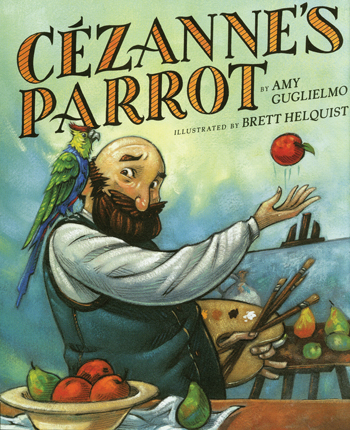| Cezanne's parrot Author: Guglielmo, Amy | ||
| Price: $6.50 | ||
Summary:
Paul Cezanne longs to be a great painter, but even with the advice of his friends Monet and Pissarro, no one, not even his parrot, is impressed with his work.
| Illustrator: | Helquist, Brett |
Reviews:
Kirkus Reviews (11/15/19)
School Library Journal (03/13/20)
Booklist (10/15/19)
The Bulletin of the Center for Children's Books (A) (00/01/20)
Full Text Reviews:
Booklist - 10/15/2019 This fictionalized account of Paul Cézanne's life centers on his struggle for recognition, nicely illustrated by the initial refusal of his pet parrot to call him a great painter. Cézanne submits his work to institutions all over Paris, takes the advice of his painter friends to persevere, and tries a variety of subjects, but the parrot still won't acknowledge his talents. Finally, he lands on the subject for which he would eventually become famous—still life portraits of brightly colored fruit—and the parrot at last exclaims, Cézanne is a great painter! Helquist's dense paintings nicely evoke Cézanne's style, with impasto brushstrokes in bold colors, thick outlines of figures, and softly blended backgrounds, and the ever-present parrot injects a healthy dose of comedy. Though the plotline and some conversations are imagined, the artist really did have a parrot who said he was a great painter, and an author's note helpfully distinguishes fact from fiction, as well as offering more background on the post-impressionist's work and legacy. An inviting, playful introduction to an influential painter. - Copyright 2019 Booklist.
School Library Journal - 03/13/2020 PreS-Gr 3—In this picture book biography, struggling artist Cezanne and his parrot, Bisou, live together in the French countryside. Cezanne's work has been poorly received by art critics in Paris. He is surrounded by a circle of high-achieving artists, but gains no popularity when he bucks tradition by working more slowly than his peers, choosing common, everyday subjects to feature, and by painting with bold confidence instead of refined delicacy. Rather than imitate his predecessors, Cezanne wants to try something new. He seeks to bolster his self-esteem by asking Bisou to say "Cezanne is a great painter," but even the bird stubbornly refuses, displaying a humorous apathy towards all attempts to train him to speak. The artist's life changes overnight when he is invited to exhibit with a like-minded group of creatives and then returns to work with a rejuvenated spirit of determination. The resulting still lifes of fruit are so winsome that Bisou approves. Exquisitely painted illustrations are paired with the text; of particular note are an early spread of Cezanne working with Bisou in a meadow and an impressive series depicting the artist laboring in nine different attitudes. The illustration is everything one would want in a book about Cezanne: bold brushstrokes, heavy lines, and a color scheme that incorporates many of the browns, blues, and greens reminiscent of Cezanne's own artistic sensibilities. Helquist skillfully expresses Cezanne's changing feelings of worry, defeat, and eventual triumph by employing carefully crafted facial expressions and body postures to convey what the artist is thinking. Helquist's depiction of Bisou is equally expressive and animated, with great detailing in the feathers. VERDICT This brilliantly illustrated picture book shares a meaningful message about how to handle criticism, being true to yourself, and finding your crew. Recommended for nonfiction collections.—Lauren Younger, University of Dallas Library - Copyright 2020 Publishers Weekly, Library Journal and/or School Library Journal used with permission.



